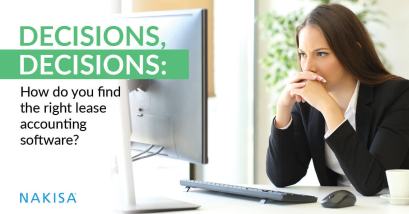A quick recap for those not already familiar with the new lease accounting standards: organizations worldwide are required to bring most leases on-balance sheet as obligations and liabilities by January of 2019. The looming effective dates for these new standards (ASC842 and IFRS16) are coming quickly and the scramble for adoption has started: How do I find a solution to support my compliance initiatives? Will it meet the needs of my global lease portfolio and accounting processes? Can I get it up and running in time?
This post focuses on the key elements you will need in a lease accounting solution that supports your ASC 842 and IFRS 16 compliance initiatives. The best solutions will go beyond the compliance bare-minimums and provide your organization with the following:
1- A single repository for your global lease portfolio
Many organizations currently have decentralized processes and disparate or informal systems for lease procurement, administration and accounting. Implementing the new lease accounting standards will require you to consider whether you can rely on your current data, systems and processes for insights. The goal should be to build a unified database for all equipment lease operations within a single solution.
2- Collaboration across the entire enterprise
As many are starting to realize, this is a cross-functional effort involving a variety of departments and business functions. Looking at your collaboration requirements involves a comprehensive assessment that goes beyond your controllers and treasurers:
- Your executives will want to understand the impact on the business
- Your auditors will need documentation of decisions with a clear audit-trail
- Your tax managers will need to understand the situational federal and state income tax implications for operating and finance leases (possibly even property tax implications)
Collaboration tools will enable users to easily validate contracts for leased equipment assets and develop a deeper understanding of the associated legal, financial, and business implications. Your new platform should also support cross-functional communication and offer the ability to track changes from multiple users.
3- Comprehensive analytics and dashboards for smart decision making
A comprehensive analytics platform will ensure that your key stakeholders have the information that they need in order to make informed business, financial, and legal decisions. You will want to be able to dynamically generate dashboards which filter your lease portfolio by contract status, phase, lease-type, and specific contract-fields. For example, can you see a disclosure dashboard outlining balance sheet entries, payment commitments, and variable lease payments? Additional key reports include comprehensive disclosure reports, weighted average reports, and payment commitment reports.
4- Unparalleled user experience and easy navigation
With the effective date of the new lease accounting standards ASC 842 and IFRS 16 less than 17 months away, your organization needs to be able to hit the ground running as quickly as possible and one of the blockers will be user-adoption. Thankfully this blocker is easily addressed early in the process by paying attention to the user-experience and user-interface of a solution. This will dramatically increase user-adoption and reduce your dependency on 3rd parties for software training and software roll-out.
5- Integration with your finance system of record
A solution that seamlessly integrates with your current ERP system will maximize your existing technology investments by leveraging current data and security infrastructure. This facilitates a smoother transition to the new standards. There are 4 key points that you will want to consider:
1) Does the solution natively integrate with your ERP out-of-the-box (set and forget)?
2) Is the integration bidirectional? Can it pull the right master-data and push back the accounting transactions?
3) Will it leverage your ERP’s user roles and security infrastructure?
4) Has it been validated or certified by your ERP vendor as safe-to-use?
The window is quickly closing for companies to invest the time and resources, including lease accounting software, required to prepare for the new standards.
This blog was inspired by a Digitalist article by Pete Graham.







